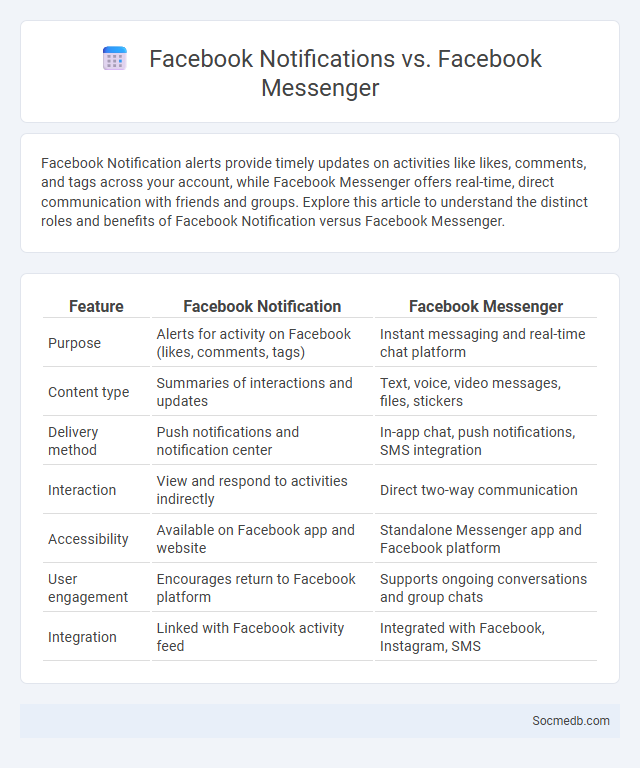
Photo illustration: Facebook Notification vs Facebook Messenger
Facebook Notification alerts provide timely updates on activities like likes, comments, and tags across your account, while Facebook Messenger offers real-time, direct communication with friends and groups. Explore this article to understand the distinct roles and benefits of Facebook Notification versus Facebook Messenger.
Table of Comparison
| Feature | Facebook Notification | Facebook Messenger |
|---|---|---|
| Purpose | Alerts for activity on Facebook (likes, comments, tags) | Instant messaging and real-time chat platform |
| Content type | Summaries of interactions and updates | Text, voice, video messages, files, stickers |
| Delivery method | Push notifications and notification center | In-app chat, push notifications, SMS integration |
| Interaction | View and respond to activities indirectly | Direct two-way communication |
| Accessibility | Available on Facebook app and website | Standalone Messenger app and Facebook platform |
| User engagement | Encourages return to Facebook platform | Supports ongoing conversations and group chats |
| Integration | Linked with Facebook activity feed | Integrated with Facebook, Instagram, SMS |
Introduction to Facebook Notification Systems
Facebook notification systems are designed to keep users informed about relevant activities, including friend requests, comments, likes, and event reminders. These systems utilize real-time data processing and personalized algorithms to ensure timely delivery of notifications across various devices, enhancing user engagement. By analyzing user interactions and preferences, Facebook optimizes notification frequency and content to maintain an effective balance between informativeness and user experience.
What is Facebook Notification?
Facebook notifications are alerts that inform users about activities such as comments, likes, messages, or friend requests related to their profile or posts. These notifications help users stay updated on interactions and important updates within their Facebook network. Users can customize notification settings to manage which alerts they receive and how they are delivered across devices.
What is Facebook Messenger Notification?
Facebook Messenger Notification is an alert system that notifies users about new messages, calls, or activity within the Messenger app. These notifications appear on mobile devices, desktops, or through email, helping users stay updated with real-time communication from friends, groups, or businesses. Customizable settings allow users to manage notification sounds, pop-ups, and vibrations to enhance their messaging experience.
Key Differences: Facebook Notification vs Messenger Notification
Facebook notifications primarily alert users about likes, comments, friend requests, and group activities within the Facebook platform, integrating various social interactions into a single interface. Messenger notifications specifically focus on real-time message alerts, indicating new chats, calls, and reactions within the Facebook Messenger app. The key difference lies in Facebook notifications encompassing broader social engagement updates, while Messenger notifications are dedicated solely to instant messaging communication.
User Experience: How Notifications Appear
Notification design significantly impacts user experience by balancing visibility and non-intrusiveness on social media platforms. Effective notification strategies include real-time alerts with customizable settings, allowing users to control sound, vibration, and appearance preferences. Platforms like Facebook and Instagram implement subtle pop-ups and badge icons to keep users informed without disrupting content engagement.
Customization and Control Options
Social media platforms offer extensive customization and control options, enabling users to tailor their feeds, privacy settings, and notification preferences. Users can curate content through personalized algorithms, block or mute accounts, and manage who sees their posts to enhance their digital experience. These features empower individuals to maintain a secure, relevant, and engaging online environment.
Device Compatibility and Delivery
Ensuring your social media content is compatible across various devices, including smartphones, tablets, and desktops, maximizes audience reach and engagement. Optimized delivery methods, such as adaptive image sizing and fast-loading videos, enhance user experience by reducing loading times and ensuring seamless access. Prioritizing device compatibility and efficient content delivery helps your brand maintain visibility and connect effectively with users wherever they engage.
Impact on User Engagement
Social media platforms significantly enhance user engagement by providing interactive features such as likes, comments, and shares that encourage active participation. Algorithms personalize content feeds, increasing relevance and time spent on the platform. Real-time communication tools and multimedia content further boost user interaction and community building.
Privacy and Security Considerations
Social media platforms collect vast amounts of personal data, making user privacy a critical concern as this information can be vulnerable to unauthorized access and misuse. Implementing robust security measures such as end-to-end encryption, two-factor authentication, and regular privacy setting updates is essential to safeguard user information. Users should remain vigilant about sharing sensitive content and be aware of privacy policies to minimize risks associated with data breaches and identity theft.
Choosing the Right Notification for Your Needs
Selecting the right social media notifications ensures you stay informed without feeling overwhelmed by constant alerts. Tailor your notification settings to prioritize updates from your most important contacts, preferred platforms, and relevant content topics. Managing your notification preferences effectively enhances your online experience and keeps Your digital interactions meaningful and timely.
 socmedb.com
socmedb.com